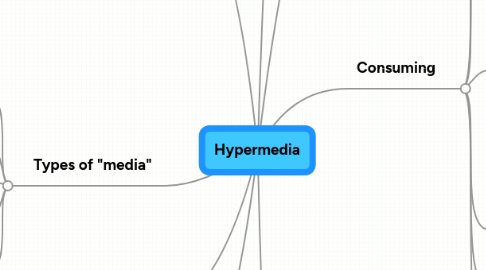
1. Origin
1.1. Hypertext came first
1.1.1. Created due to the "problems of loss of information about complex evolving systems"
1.1.2. Easier than trees or keywords to access information.
1.2. Needed to be portable (or supported on many platforms) and extendible to new data formats.
1.3. Hypermedia Systems
1.3.1. Hypercard was one of the first hypermedia systems. (Preceeded the World Wide Web).
1.3.1.1. Application program designed by Bill Atkinson and introduced by Apple in 1987
1.3.2. Xanadu
1.3.2.1. tool conceived by Nelson to preserve and increase humanity's literature and art
1.3.2.1.1. would allow information to be stored not as separate files but as connected literature that is always accessible
2. How is Multimedia different?
2.1. Multimedia combines all the types of media, but unlike hypermedia, it presents them in a specific linear way, designed by the creator. The user has no choice in the sequence.
2.2. Multimedia of Martin Luther King's "I Have a Dream Speech"
2.2.1. Audio and Visual Media add to the interpretation of the speech in addition to text only.
3. Types of "media"
3.1. audio
3.1.1. Is expressive whereas simple text isn't
3.1.1.1. Appealing for non-readers
3.2. images
3.2.1. Adds to the meaning of a message and aids in understanding.
3.2.1.1. Can lack details - students must be guided to the importance of message
3.3. text
3.3.1. Portable and easily reviewed
3.3.1.1. Lacking the visual appeal
3.4. video
3.4.1. Engaging and stimulating for visual learners
3.4.1.1. highest information content media
3.5. hyperlinks? (would this be considered a type of media?)
4. Media Graffiti
4.1. same as types of "media"- only visually displays pictures and text to instill the main components.
4.1.1. Visual, Audio, Images, Text, and Video
5. Definition
5.1. Hyper- :
5.1.1. above, beyond, existing in more than 3 dimensions, non-linear, linked non-sequentialy
5.1.1.1. linked or arranged non-sequentially
5.2. Media:
5.2.1. a medium of expression
6. People
6.1. Vannevar Bush - Godfather of our wired age, came up with a theoretical machine called the "memex," which was to enhance human memory by allowing the user to store and retrieve documents linked by associations.
6.2. Ted Nelson - Not a believer of today's Hypermedia. Coined the term "hypertext"
6.3. J. C. R. Licklider - Theorized that computers would augment human intellect by freeing it from mundane tasks. Foretold of graphical computing, point-and -click interfaces, digital libraries, e-commerce, online banking, and software that would exist on a network and migrate to wherever it was needed. Been called "Computing's Johnny Appleseed."
7. Consuming
7.1. linked to media literacy
7.2. Strategies for "reading" hypermedia must be taught so students learn while also being entertained.
7.3. must control your ADD because there are a lot more distractions
7.4. Difference between consuming linear vs. non-linear media
7.4.1. Linear
7.4.1.1. Order can help students understand key concepts.
7.4.1.2. meets students at their level
7.4.1.3. cannot be changed very easily
7.4.2. Non-linear
7.4.2.1. Reader has to make choices
7.4.2.2. Easy to get lost or distracted
7.4.2.3. More complex than linear - shows more connections
7.4.2.4. shows there are many ways to connect content
7.5. Authors must pay attention to audience and reading level.
7.6. TV and movies are popular sources for our students to gain information.
7.7. The internet offers text, audio, video, etc. to students (not ordered in a particular way)
8. Producing
8.1. Requires different production skills for different types of media
8.2. Must decide what medium is best for conveying certain information.
8.3. Difference between producing linear vs. non-linear media
8.3.1. Linear
8.3.1.1. Must have skills in ordering information
8.3.1.2. Requires blending multimedia into a logical sequence.
8.3.2. Non-linear
8.3.2.1. Decisions must be made about how content is connected
8.4. Producing media does not mean you are media literate
8.4.1. must have necessary skills in order to produce media in a meaningful way
8.5. reorganizing, find more information, and choosing a media platform create strong learning experience
8.5.1. students will "own" their learning
